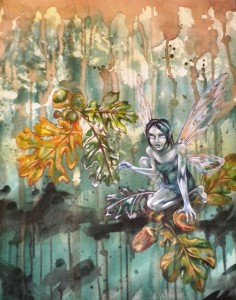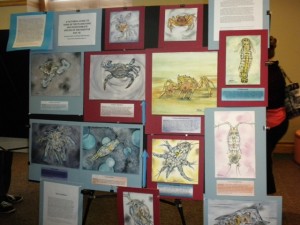
Danielle Sobol ’12 takes water samples from Raritan Bay in New Jersey.
By Michele Tallarita ’12
Danielle Sobol ’12 is concerned with liminalities.
“A liminality is an in-between state. A liminal being could be an adolescent, in between a child and an adult,” she says. “In a lot of urban-fantasy novels, there are worlds that are in between reality and mythology.”
Sobol (Wall, N.J.) is exploring liminalities this year in her thesis, in which she is producing a body of artwork depicting these in-between states. Sobol is a bit of a liminal being herself. As a self-designed interdisciplinary major combining studio art and biology, as well as a pre-med student, she spends much of her time in the cross-section between the arts and sciences.
Sobol compares being an artist to being a natural athlete—it’s an identity she feels like she was born with. “My mom took pictures of me at 2 years old drawing on a Magna Doodle,” she says. “There’s a sun with butterflies and flowers—it wasn’t just a scribble.”

A fairy painting for Sobol's honors thesis
At the age of 9, she started taking oil painting lessons at an art school, and has continued honing her talent ever since. As part of her major, she has taken drawing, painting, and printmaking classes. Her thesis, conducted under the tutelage of Ed Kerns, Clapp Professor of Art, is the culmination of her artistic training at Lafayette, and focuses on the liminality of fantasy realism. She’s also interested in bringing in the fantastic subject matter of Irish folklore and other mythologies, from which liminal beings like fairies first sprang.
“In this age of advanced science and knowledge, we know so much and have kind of disproven the belief systems around these imaginative stories, yet people are still drawn to these ideas,” Sobol says. “It’s interesting how they were born out of fear and awe and mystery. You’d think if you’re scared of something, you’d want to turn away from it, yet cultures always return to these influences for storytelling.”
Though her thesis deals primarily with the arts, Sobol has conducted other projects that combine both the art and biology aspects of her major. During her sophomore and junior years, she did research under Megan Rothenberger, assistant professor of biology, involving the increasing plant biomass of Raritan Bay in New Jersey. This research came to a head this summer when Sobol worked as a Mellon Scholar collecting water samples from the bay, then performing chemical and biological analyses—a process that often involved getting in a boat.

Examples of the pictorial guide Sobol produced about her research at Raritan Bay
While the bulk of the Raritan Bay project made use of her knowledge of biology and skills in the lab, the conclusion took a twist that catered to Sobol’s artistic side. “To sum up my research and what we found, Professor Rothenberger suggested a pictorial guide of the most abundant phytoplankton species—which was right up my alley,” she says. The paintings of phytoplankton that resulted were good enough to find their way to the walls of Kunkel Hall.
After graduation, Sobol plans to go on to medical school and become a doctor—a path that she thinks will perpetuate her practice of straddling disciplines. “I like how it’s more than just science. It also incorporates a lot of humanities,” she says. “As a doctor, you’re interacting with people every day, and you never know what’s going to come up.”
Where does she see her gifts as an artist coming into play? Interestingly enough, under the bright lights of the operating room.
“Surgery is where I see the biggest crossover with art,” she says. “They’re both very intuition-based. You can’t just memorize a textbook and know how to do it. There’s a feel to it.”



1 Comment
Glad to hear about Ms. Sobol’s work. I am in the same line and I wish her all success.
Comments are closed.